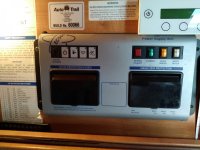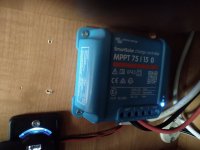I would guess a 2010 Autotrail Mohawk will have either a Sargent EC325 or a Sargent EC328. (and to add a slight confusion, if the EC325 was ever returned to Sargent for a repair, it is likely they upgraded it to a EC328 and that may or may not be noted on the case. I don't know if they did).
Check the big number on the Silver Sargent box - located in the top locker behind the Drivers I would think in your Motorhome? Let us know what it is.
The EC325 has a basic "power supply" charger. I have found it is a 13.8V Supply. It won't go higher, so won't charge the
battery fully. It won't go any lower, so is at the top end of a float voltage.
The EC328 has according to the Sargent specs a much better
Battery Charger and IIRC is a 3-stage charger much more like a smart charger.
IF you are seeing the vehicle
battery dropping when the charger is off, then that suggests you have the control panel set so the hab electrics are running off the Vehicle
Battery and not the Starter
Battery, as the Sargent charger will only charge whatever
battery is selected (when you have the EC325/EC328 and many/most other Sargent models).
(I think we have had a conversation about the Sargent control panel and how the
battery selection works?)
Are you doing the right thing? If you are using the Sargent Charger, and especially if you have an EC325 then you are doing absolutely the right thing by powering it on periodically. I would maybe have it switched off much more than on though. The
battery will charge much faster than it will discharge parked up.
Personally speaking, I would get an external better smart charger to charge the batteries. It will charge them correctly to the right levels. It will also be more efficient and only charge when the
battery needs it - if you have
solar and the charge from the
solar controller is more than the
battery loads, that will look after the
battery and the mains charger will still there plugged in but doing nothing, so even though you ARE plugged in, you are still getting free
solar polar instead of using expensive grid power. I often leave my motorhome plugged in for weeks and during the day the grid power is maybe 2-3W but the
solar is 100W or whatever.
However/But (always a but

) - If you add an external Charger, that will work on the Leisure
Battery and it doesn't matter what
battery is selected on the control panel, it charges the Leisure
Battery regardless. You really want to be selecting the Leisure
Battery anyway on the Control Panel by default. And then to charge the Vehicle
Battery periodically, switch to Vehicle and turn the Sargent charger back on; or get a little
battery maintainer such as a Vanbitz
Battery Master or the much superior Ablemail AMT12 which will send a small charge current to the vehicle
battery whenever the Leisure
battery is being charged by
solar or by mains.



